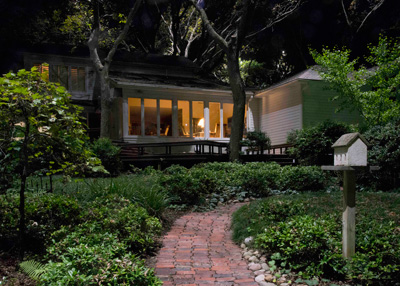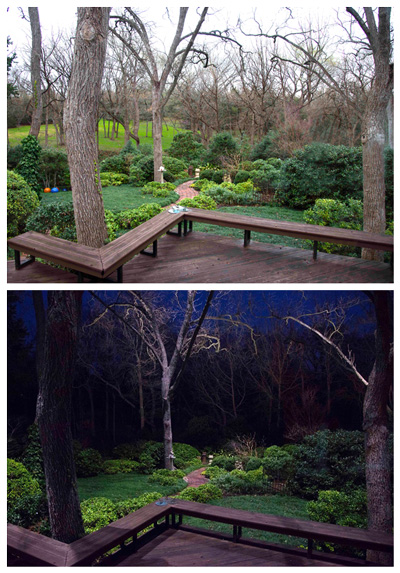Lighting the Night

Photo: Lentz Landscape Lighting highlights the Sperry backyard every night of the year. Click image for larger view.
That first landscape lighting at Texas A&M was installed by John Watson Landscape Illumination, and it was casually referred to as “artificial moonlight.” That was a pretty apt description, and it set the course for a new aspect of landscaping. But we Sperrys didn’t have trees tall enough to justify it at that point.
Jump ahead 15 years. I’d finished two degrees and had just left Texas A&M employment after seven years to pursue commercial radio. We’d bought a home nestled in a forest of tall pecans. So we had the house and we had the trees, but we didn’t have the funds.
So I went to the store and bought one of those boxed kits of DIY lighting. Well. Let me tell you: that was a joke. They never looked real, and when the bulbs started to burn out after a few months, there was no way to replace them. You simply had to replace the entire set. That ended poorly.
A guy came to me and told me he was just getting into the business – that he’d like to learn, and he’d “give me a deal” if he could learn on my trees. And that was just as bad. I knew more than he did, and that money poured down the rat hole as well.

Photos: Late-winter look of our landscape in daytime and later the same night. Note how the illumination gives a cheerful, intimate feel to the garden.
And then, along came Lentz…
Watching my misery, one of my nursery friends quietly said, “Neil, why don’t you put all that behind you and just call Dick Lentz? He’s a great guy, and his work is second to none. You’ll love working with him.”
That was 30 years ago, and that friend was absolutely correct. They don’t make ‘em any nicer than Dick Lentz, and work isn’t done any better than work that’s done by Lentz Landscape Lighting. (At some point here I do need to disclaim myself by saying that they do advertise in e-gardens, but I’d be saying these same things even if they did not.)
Watching Dick Lentz and his crews work, I’ve learned a good bit about landscape lighting (with much more to go).
• Lighting should be planned for (1) aesthetics, (2) safety and (3) security.
• Choose the focal points that need to be highlighted, then determine the best angles to accomplish the task.
• Less is more: Dick uses fewer fixtures than many might, but he installs them higher in trees for a wider, softer look.
• LED lighting is the only way to go. The fixtures are smaller and more easily hidden, and the lamps last for thousands of hours, costing far less to operate in the process. Old systems can be retrofit to utilize new LED fixtures.
• Up-lighting onto the sides of buildings and tree trunks adds drama, but it must be done carefully.
• Back-lighting adds depth, but again, it must be planned by a professional if it’s going to look natural.
• Specialty lighting for parties, pools, decks and steps can provide added highlights.
• Contrary to what we (and most others) thought originally, your lighting is just as nice in the winter as it is in the growing season, even though many of your trees will be bare.

Photo: This winter scene of my Glendora White crape myrtle with Lentz Lighting illumination is my iPhone’s wallpaper. It reminds me of one of my favorite plants highlighted by one of my favorite people. You’re welcome to copy and use it if you so wish.
To learn more about Lentz Landscape Lighting, visit their website. You’ll see our backyard in their slide show. http://www.lentzlandscapelighting.com
